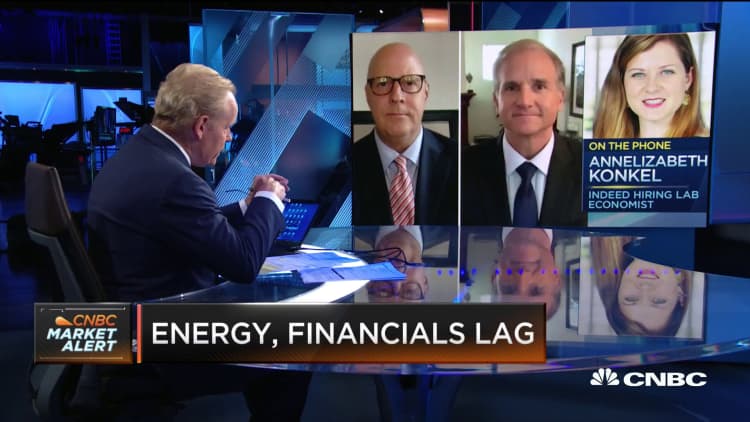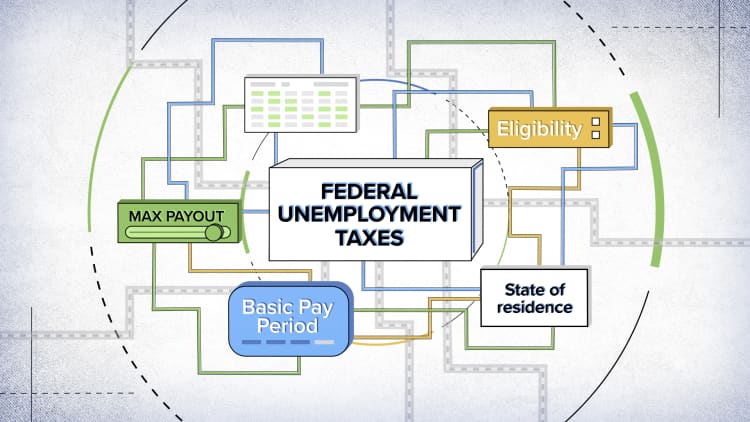The federal government has approved nearly a dozen states to pay an extra $300 a week in unemployment benefits.
But jobless Americans shouldn't expect that money anytime soon.
In fact, it may take about a month or two in some cases, according to state officials, who are scrambling to understand specific rules and figure out how to administer aid through what amounts to an entirely new program.
That timeline conflicts with a rosier view espoused by White House officials since Aug. 8, when President Donald Trump signed an executive measure creating the "lost wages" assistance program.
More from Personal Finance:
Why there's still hope for second $1,200 stimulus checks
Thousands may not get the extra $300 unemployment benefit
Here's the relief you can actually count on
The measure came after a federal $600-a-week unemployment boost stopped at the end of July, leaving the average worker with about $300 a week. Some get much less, as little as $5 a week.
"I think really the next week or two, you're going to see a lot of checks minted to unemployed people at the federal level and the state level," White House economic advisor Larry Kudlow said Wednesday.
There are many reasons why the aid may be delayed beyond that time frame.
Up to 8 weeks?
Firstly, unemployed workers must wait for their state to apply and be approved for the $300-a-week federal subsidy, which comes on top of existing state benefits.
Nineteen states had applied as of Thursday morning, according to Keith Turi, assistant administrator of recovery at the Federal Emergency Management Agency, which is overseeing the aid program.
Eleven of them have gotten federal approval to offer three weeks of aid, totaling more than $2.4 billion, John Pallasch, assistant secretary for employment and training at the U.S. Labor Department, said Thursday.

On Monday, Arizona became the lone state to start paying the $300 benefit to eligible workers, according to Brett Bezio, a spokesman for the state's Department of Economic Security.
Officials in other approved states — Colorado, Idaho, Iowa, Louisiana, Maryland, Missouri, Montana, New Mexico, Oklahoma and Utah — suggested unemployed workers could be waiting much longer.
Utah, for example, expects to start paying the benefit within four weeks, according to Bethany Hyatt, a spokeswoman for the Utah Department of Workforce Services.
Colorado expects to start paying in mid-September.
There are a lot of moving parts here. And it'll take us a few weeks to get it up and running.Bill McCamleycabinet secretary for New Mexico's Department of Workforce Solutions
Indiana, which has applied for the assistance, plans to start disbursing funds in the next three to four weeks, according to the state's unemployment website.
In Alaska, the timeline is longer still — about six to eight weeks from application approval, Cathy Munoz, deputy commissioner of the state's Department of Labor and Workforce Development, said in an e-mail on Wednesday.
The state submitted its application Wednesday, Munoz said.
"This stuff generally doesn't happen at the flip of a light switch," said Bill McCamley, Cabinet secretary for New Mexico's Department of Workforce Solutions.
"There are a lot of moving parts here," McCamley said. "And it'll take us a few weeks to get it up and running."
Congress may, of course, reach a deal on financial relief in coming weeks. Provisions around a weekly unemployment boost would supersede Trump's executive measure.
Unemployed workers will receive the $300-a-week payments back to the week ended Aug. 1.
'All over the map'
The $300 weekly federal boost isn't technically unemployment insurance — it's a new federal program with rules and requirements that state officials must decode.
States are essentially building "a whole new system from scratch," which must operate in parallel with their existing unemployment framework, McCamley said.
The lost wages program has some rules that don't jibe with states' current framework, he added.
For instance, unemployed workers getting less than $100 a week in state benefits don't qualify for the aid. State systems must be programmed to account for that.

States are also used to interfacing with the U.S. Labor Department relative to unemployment benefits. Here, unemployment agencies are working with a new federal partner, FEMA, since the program funding is sourced from a federal disaster relief fund, McCamley said.
"It will be all over the map," Pallasch said of state timelines to pay the benefit.
Speed will depend on complexity of states' unemployment systems and the breadth of their IT staff, he said. As a result, some states may take one or two weeks, while others take four, five or six, he said.
The federal government has offered IT assistance to help states implement the benefit more quickly, Pallasch said.
Meanwhile, it's been about three weeks since unemployed workers stopped receiving a $600-a-week unemployment subsidy enacted by a federal relief law in March.
That's left about 28 million workers collecting unemployment benefits with just their state allocation.
In June, workers got $308 a week, on average, according to Labor Department data. States like Louisiana and Mississippi paid less than $200, on average.
People who eventually get the $300-a-week unemployment boost likely won't get it for long.
States are only guaranteed for three weeks of funding. After that, some may get more based on a week-by-week assessment of program funding, Turi said.
Officials expect states will get about four to five total weeks of funds.
"This program could run out of money immediately" after states make their first payments, said Ernie Tedeschi, an economist at Evercore ISI. "We could be right back to square one in this whole issue in early September."


